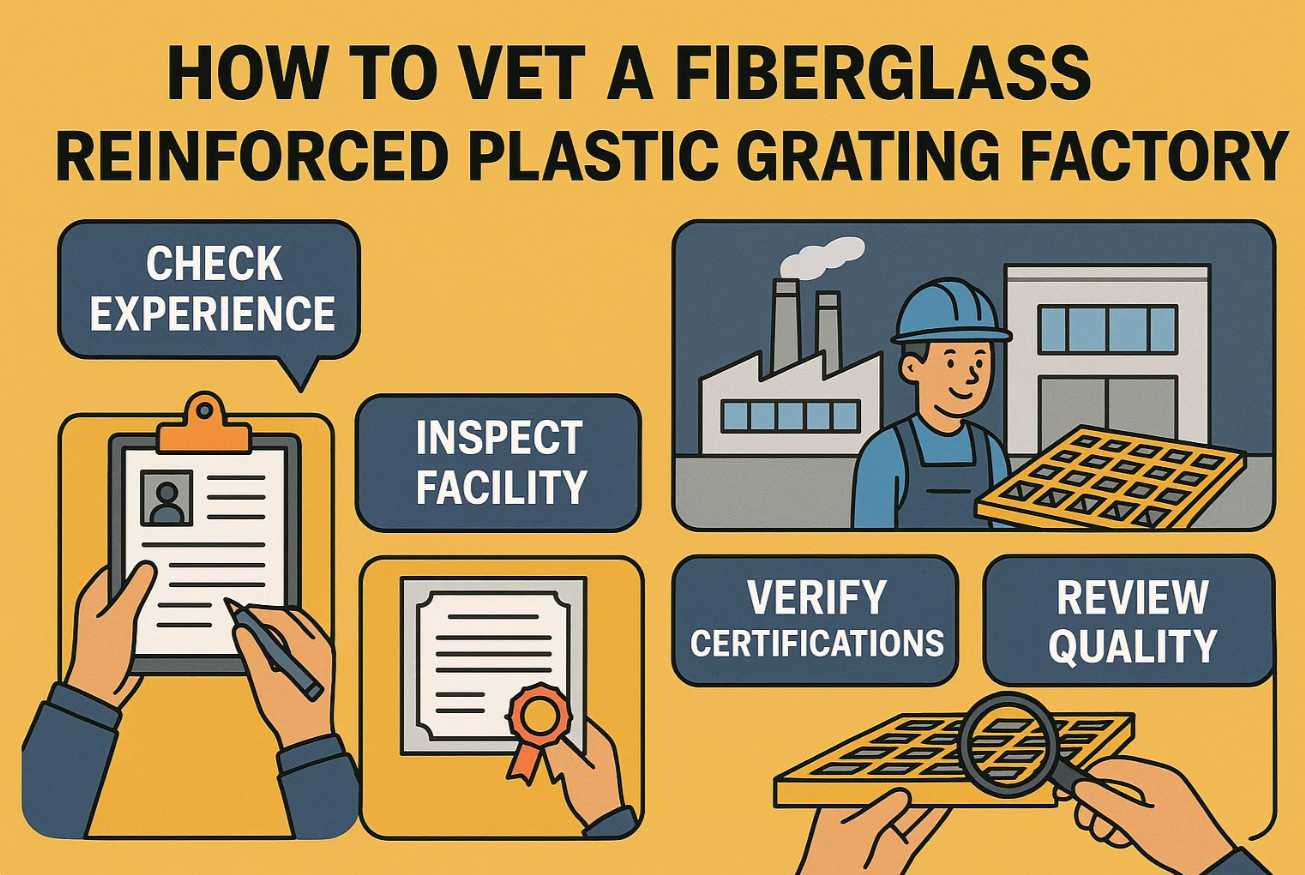Introduction
Imagine stepping onto a coastal catwalk that must withstand salt spray, forklift traffic, and 24/7 operations. If the grating flexes, slips, or corrodes, lives and budgets are on the line. That is why qualifying the fiberglass reinforced plastic grating factory behind the product is every bit as critical as the engineering specification itself. Unicomposite—an ISO-certified pultrusion specialist with decades of shop-floor experience—illustrates what to look for when you vet suppliers.

fiberglass reinforced plastic grating factory
What Makes a Reliable Fiberglass Reinforced Plastic Grating Factory
Proven Experience & Industry Track Record
A seasoned plant shows evidence—photos of installed platforms, reference letters, repeat orders—stretching back ten years or more. One petroleum client I guided trimmed replacement cycles from five years to fifteen years by switching to a shop whose composite lineage began in 1998.
“Long service history is the truest form of certification,” notes Dr. Zhou, materials professor at Zhejiang University.
Certifications, Standards & Third-Party Audits
Look for ISO 9001 and ISO 14001, plus product testing to ASTM E-84 flame-spread ≤25. OSHA 1910 slip-resistance data should be on file. A 2024 NAMIC survey found 78 % of industrial buyers ranked certification a top-three decision factor.
Inside the Factory: Core Production Capabilities
Raw Materials Selection & Pultrusion/SMC Lines Explained
A top-tier fiberglass reinforced plastic grating factory stores rovings and resins in climate-controlled rooms (<25 °C, 50 % RH) and runs multiple pultrusion lines plus SMC presses for molded panels. Unicomposite operates 16 lines; one pulls a 50 mm walkway beam every 90 seconds—proof of scale and consistency.
In-House Testing, QC Labs & Statistical Process Control
Continuous sampling keeps variation below ±2 %. Tensile coupons are cut every eight hours, and a laser micrometer logs web thickness in real time. In 2023, one audited facility recorded a 0.6 % internal reject rate versus the industry average of 2.8 %.
Environmental, Health & Safety Practices
“Production speed means nothing if we compromise safety,” says Ms. Liu, EHS manager at Unicomposite. The plant posts a lost-time incident frequency of 0.7 per million hours—half the Chinese composite-sector average.
Engineering Support & Customization Services
Design-for-Manufacture Collaboration & CAD Integration
Profitable projects begin in the engineering office. Look for 3-D modeling that plugs into SolidWorks or AutoCAD. The best teams run finite-element checks to ensure 2 % maximum deflection at design load.
Prototyping, Custom Tooling & Small-Batch Runs
Need a 38 mm deep panel with integrated anti-spark inserts? A responsive shop can machine an aluminum die in two weeks and ship pilot pieces within 30 days, cutting your development cycle by up to 40 %.
Case Study: Waste-Water Treatment Platform Retrofit
A Mid-Atlantic utility had to replace corroded steel decking above acidic clarifiers. The factory analyzed load maps, proposed a 1.5″ pultruded grating with vinyl-ester resin, and delivered 1,800 m² within eight weeks. Field feedback after 18 months: zero delamination, zero worker slips, maintenance budget down 22 %.
Supply Chain & Logistics Considerations
Lead Times, Minimum Order Quantities & Incoterms
Standard panel sizes (1,220 × 3,660 mm) ship in 4–6 weeks; custom colors add one week. Typical MOQ is 200 m². Ask whether the factory offers FOB Shanghai, CIF Houston, or DAP Rotterdam to simplify freight comparisons.
Total Cost of Ownership vs Unit Price
Replacing steel with FRP usually carries a 15–20 % premium upfront. Yet a 2024 Deloitte analysis showed lifecycle savings of 34 % over 20 years once maintenance labor and downtime were included. Sharing such data with finance teams accelerates approval.
Conducting Your Factory Audit
A 2025 Composite Fabricators Association survey found buyers who performed on-site audits cut warranty claims by 12 % within two years.
Pre-Visit Desktop Research Checklist
Download and review ISO certificates.
Verify ASTM, EN, or BS test reports are current (<12 months).
Map customer reviews on LinkedIn and industry forums.
On-Site Walkthrough: 10 Critical Questions to Ask
How old is each pultrusion line, and what upgrades are planned?
What resin brands are approved?
How is glass/resin ratio recorded?
Show the last SPC chart.
Demonstrate spark-testing and UV-aging ovens.
Explain evacuation drills.
How are non-conformities traced?
Which third-party labs certify fire performance?
How many QC inspectors work each shift?
May we interview welders and CNC techs?
Post-Audit Scorecard & Decision Matrix
Rate suppliers 1–5 across Quality, Engineering Support, Capacity, Compliance, Cost, Communication. Weight each by project risk so gut feel becomes a defendable shortlist.
Conclusion
Vetting a fiberglass reinforced plastic grating factory hinges on six pillars: experience, certifications, process control, engineering depth, logistics, and a structured audit. Unicomposite’s blend of ISO discipline, in-house testing, and responsive design support shows how a supplier becomes a long-term partner. Ready to build safer, lighter, corrosion-proof flooring? Reach our composites team or request a tailored quote today.
Frequently Asked Questions
Q1: How long does fiberglass grating last in corrosive sites?
A well-formulated vinyl-ester panel can exceed 25 years in acid, provided loads stay within design limits and the surface is inspected annually.
Q2: Can I order custom colors or fire-retardant grades?
Yes. Factories running both pultrusion and SMC presses can tint resins to RAL shades and add halogen-free fire retardants without affecting strength.
Q3: What documents should accompany each shipment?
Expect a mill certificate listing glass content, resin type, bar-code traceability, plus ASTM E-84 and ASTM D-635 reports less than a year old.
Q4: Do I need special tools to cut FRP grating on-site?
Carbide-tipped circular-saw blades and diamond abrasives work best; seal any exposed edges with the supplied resin gel to block wicking.
Q5: How do freight terms affect landed cost?
FOB gives you control of ocean freight but adds admin; DAP or DDP lets the factory roll logistics into one figure, which can save 3–5 % for first-time importers.
 info@unicomposite.com
info@unicomposite.com


























